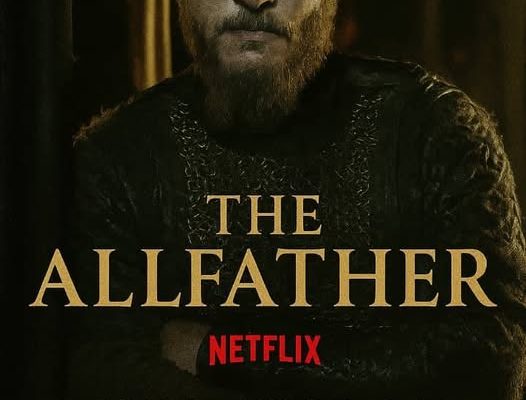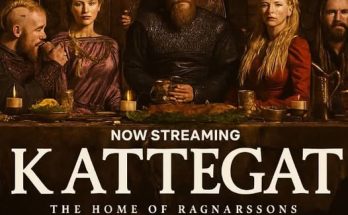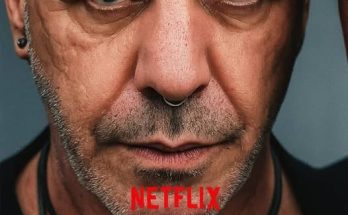The new Netflix release, The Allfather, has quickly risen to become one of the most talked about shows in recent memory, capturing the imagination of audiences across the globe with its bold storytelling, compelling characters, and cinematic scale that feels tailor-made for a streaming giant known for its ability to create cultural phenomena. Since its release, The Allfather has generated intense discussions online, sparked countless theories, and already seems destined to leave a lasting impact on Netflix’s library of standout productions.
From the moment it was announced, The Allfather carried an air of mystery and anticipation. The title alone suggested something grand, mythological, and powerful, hinting at a narrative that would draw on archetypes as old as human history itself. When the show finally landed on the platform, it quickly became clear that it was more than just another original release. It is an ambitious project that manages to merge elements of myth, drama, and action into a series that not only entertains but also provokes thought. The way it connects ancient themes with modern sensibilities has allowed it to resonate deeply with audiences, both casual viewers and those with a taste for layered storytelling.
Much of the buzz surrounding The Allfather comes from its central figure, the enigmatic leader who embodies both strength and vulnerability, tradition and rebellion. The character of the Allfather is painted not simply as a mythological figure of power, but as a humanized and complex individual wrestling with authority, loyalty, and the crushing weight of expectation. Viewers are drawn not just to his commanding presence, but also to his moments of frailty, which make him relatable and anchor the narrative in real emotion. In a world overflowing with one-dimensional heroes and villains, the Allfather stands out as a figure whose journey feels grounded in conflict and humanity.
The writing in The Allfather deserves much of the credit for its early success. The dialogue strikes a delicate balance between poetic weight and contemporary accessibility. On one hand, the characters speak in a way that evokes the grandeur of epic sagas, filled with lines that echo timeless struggles and philosophical questions. On the other, the writing avoids pretentiousness, ensuring that audiences do not feel alienated. This balance allows the show to speak to both fans of mythology-inspired storytelling and those who simply want gripping drama. The narrative unfolds in layers, alternating between grand spectacle and intimate character moments, and this structure has kept viewers engaged and eager to return to the story.
Another significant reason The Allfather has already begun to make waves is its world-building. Netflix has spared no expense in creating an environment that feels rich, immersive, and authentic. The landscapes are breathtaking, ranging from snow-capped mountains to dense forests, ancient halls carved of stone, and war-torn fields that remind viewers of both medieval Europe and mythological landscapes. The costumes and production design contribute to the immersion, paying attention to detail in a way that makes the fictional world feel lived in and credible. Every shot appears deliberate, and the visual storytelling amplifies the themes of tradition, heritage, and power that lie at the show’s core.
The performances by the cast elevate the material to even greater heights. The actor portraying the Allfather has already received widespread praise for bringing nuance to a role that could easily have slipped into caricature. Instead of presenting the Allfather as a purely stoic or intimidating figure, he infuses the character with charisma, wisdom, and moments of doubt that give the portrayal layers of authenticity. The supporting cast is equally strong, with standout performances from those playing rivals, allies, and family members. Their chemistry on screen has added depth to the show’s dynamics, ensuring that no relationship feels flat or formulaic.
One of the most striking elements of The Allfather is how it engages with themes that remain relevant to modern audiences despite being rooted in mythological inspiration. Authority and power are central concerns, as the story explores the tension between maintaining tradition and adapting to changing times. The Allfather is caught between worlds, struggling to uphold the legacy of his forebears while recognizing the need for transformation. This duality mirrors many contemporary discussions about leadership, culture, and progress, making the series resonate beyond its fantasy setting. Viewers see in the Allfather’s struggles a reflection of real-world dilemmas, and that universality is part of what has driven the show’s popularity.
The action sequences have also garnered attention, blending the visceral intensity of large-scale battles with the artistry of carefully choreographed duels. These scenes are not gratuitous but are instead used to advance the story, highlight character arcs, and underscore the stakes. Every battle feels personal, even when involving entire armies, because the show makes sure to remind viewers of the human cost behind the spectacle. The combination of stunning cinematography and emotional storytelling ensures that the action never overshadows the narrative but instead reinforces its themes.
What has surprised many critics is the emotional weight of The Allfather. Beneath the sweeping battles and political intrigue lies a story about family, legacy, and identity. The Allfather’s relationship with his children and allies provides some of the most heartfelt moments of the show. His attempts to reconcile the burdens of leadership with his personal desires and responsibilities create tension that feels both epic and intimate. These moments ground the show, reminding audiences that even gods, kings, or mythical figures wrestle with the same fundamental questions of belonging, sacrifice, and love.
Social media has played a massive role in amplifying the show’s impact since its release. Fans across platforms like Twitter, TikTok, and Instagram have flooded timelines with discussions, fan art, and speculative theories about what lies ahead. Memorable lines of dialogue have gone viral, and certain scenes have already been dissected frame by frame in online forums. This level of engagement is a strong indicator of the cultural wave The Allfather is riding, with its potential to become one of Netflix’s signature franchises. The show has also sparked debates about myth, history, and the blending of fact and fiction in storytelling, showing that it is connecting on intellectual as well as emotional levels.
Early reviews from critics have been overwhelmingly positive, praising its ambition and execution while noting its potential for further growth. Some have compared it to other landmark series that defined their cultural moment, pointing out that The Allfather could occupy a similar place if it sustains its quality and momentum. The series has been lauded for avoiding the pitfalls of overstuffed exposition, instead trusting viewers to piece together elements of its lore as they go. This choice has invited rewatchability, as audiences pick up on details they may have missed during their first viewing.
The show’s music has also been a standout feature, blending orchestral grandeur with atmospheric tones that complement the visuals. The score heightens the sense of immersion, adding emotional depth to pivotal scenes and creating an auditory signature that fans already associate with the show. A strong soundtrack has often been a hallmark of series that endure in the cultural imagination, and The Allfather appears to have joined those ranks with music that lingers long after the credits roll.
The global appeal of The Allfather cannot be ignored. While steeped in mythological inspiration, the themes are universal, and Netflix’s platform ensures accessibility to audiences in every corner of the world. Subtitles and dubbing have allowed viewers from different cultures to engage with the story, and its combination of spectacle and humanity has transcended linguistic and cultural barriers. This international resonance has contributed to the rapid growth of its popularity, ensuring that conversations about the show are happening in multiple languages and contexts simultaneously.
As The Allfather continues to make waves, speculation has already begun about its future. Will Netflix expand it into multiple seasons? Could spin-offs or companion stories follow? Fans are eager for answers, and the early success makes it highly likely that the platform will capitalize on the show’s momentum. The appetite for rich, epic storytelling has proven to be alive and well, and The Allfather seems poised to fill that demand for years to come if handled carefully.
Ultimately, the success of The Allfather lies in its ability to combine the epic with the personal, the mythic with the human. It delivers the spectacle expected of a high-budget Netflix release while grounding itself in universal themes of leadership, sacrifice, and identity. Its arrival has reminded audiences of the power of storytelling that draws from timeless archetypes while speaking directly to contemporary concerns. In a crowded entertainment landscape, The Allfather has distinguished itself not just by spectacle, but by depth, leaving a strong impression that this is not merely another release, but a cultural event in the making.
The waves The Allfather is making since its release show no signs of subsiding. With its ambitious scope, compelling characters, and emotional resonance, it has already solidified itself as one of the most significant new additions to Netflix’s lineup. For viewers around the world, it is more than just a show; it is an experience, a conversation, and potentially the beginning of a new era for myth-inspired storytelling on streaming platforms. Its legacy is still in its infancy, but the early signs suggest that The Allfather may well stand among the greats of modern television, a testament to the enduring power of narrative that bridges past and present, myth and reality.



